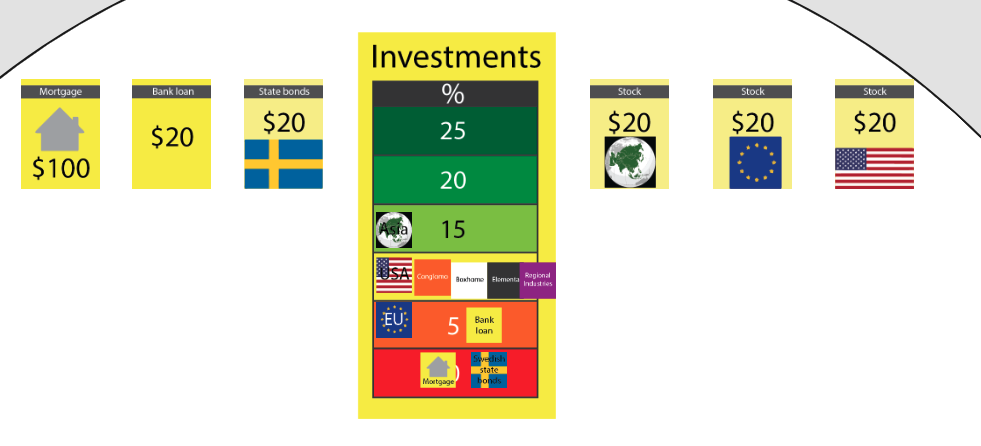We’ve recently concluded three playtests before which the game was developed and redesigned since the playtest in December, after which I wrote four blog posts describing the game in the state it was then. The first playtest was held at Lund University and comprised some 30 students, the second was part of the course in megagame design for sustainable development running at Linköping University this spring and was played by just under 20 students (and Darren Green, visiting megagame designer from the UK, who also played his megagame Two Degrees to Midnight with our students), and the third was held at Dalarna Science Park in Borlänge and was attended by some 25 professionals and students with connection to the energy sector in various ways.
This blog post will deal with the mechanical implications of playing megagames with 25–40 people coupled with things I learned and realised about megagames and Switching the Current while discussing the game with Darren Green during his visit to Linköping in January 2023. The next two blog post will deal with the efforts involved in localising the game to the county of Dalarna (it was originally set in Östergötland), and what the players and I experienced during the playtests, respectively. This and the next blog post will be more about game mechanics, and the third will focus more on the learning outcome of playing the game – and how to tailor it to do what we want it to: promoting better discussions about how to achieve a sustainable energy system.
All along, I’ve been designing this game with a view to a final version of 50–100 players. However, after discussing matters with Darren Green, I came to realise that ever since we started designing megagames in 2019, we’ve been getting signals that groups of 30 are the largest that the people we have talked to can imagine ever getting together. There are many reasons for this, but the bottom line is that I understood that for the time being, I’ll have to design a megagame that works well for between 20 and 40 participants. The implications of this realisation was that I decided to better define the ‘borders’ of the game, and so make hard decisions regarding which tables are to be played by teams and which are to be reduced to game mechanics handled by Control. One such table was the bank (Fig. 1), which was reduced to a single board showing the return rates on investments; two tables that have yet to be emerge also suffered the same fate, namely the Goods and Food tables, which will be developed as game mechanics rather than as tables played by teams of players (at least for the time being).

The second implication of this realisation was that it would no longer do for tables to be played by less than two players (the least amount of players necessary to form a team) as this impacts the game experience too much; players will naturally form teams, and if they are alone they will do so with players playing other tables, which in the end makes for an unbalanced game experience. The practical obstacle was that we rarely know who is coming to a playtest beforehand and that we’ve received indications that very few people are prepared to read anything beforehand, meaning that roles will only ever be handed out when players arrive to the venue. To handle this situation, I constructed a list of roles to be handed out, ordered so as to form teams of two for the most basic functions (populations, energy companies, mayor + CFO) first, then open up more tables if there are enough players (researchers, local administrations departments, researchers, interest groups), and finally add a third player to existing teams. This means that there’s a minimum number of players (16) below which there’s no point in running the game as players will be ‘overworked’, as well as a ‘maximum’ number (39) above which no more functions are being added to the game, but teams would simply have more players with no specific roles or goals apart from that of the team.
I learned something valuable by playing Two Degrees to Midnight: After getting acquainted to the game and their team members, the leaders of three world powers spent most of their rounds (all time aside from the team and resolve phases) away from their team; they went to a separate room together with the UN Secretary-General, where they then discussed world politics, devised strategies, and issued orders for the other members of their team to carry out (as best they could). I had previously stumbled on this idea and vaguely introduced into the game, as I was not sure what it would do, but after seeing it in play I implemented it fully to the Regional Council. Currently, the Mayor assembles and heads the Regional Council, which consists of one player from each of the population tables (politicians – a role in the game), and the function of which is to give the Mayor instructions how to manage the local administration tables. The voting system is that if two players agree, the motion carries – however, if someone requests a vote, players will vote using influence tokens, which are not evenly distributed and may even belong to players outside of the Regional Council, such as the CEO of Boxhome, representing the oil and gas lobby.
These are some of the design decisions taken during the development for two of the playtests – in the next blog post I’ll cover the localisation of the game to a different county.
